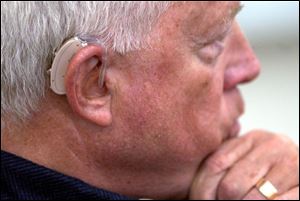
Firms' audio system gift clears up noise for the hearing impaired
4/13/2005
An induction loop system, which recently was donated to the Ability Center of Greater Toledo, allows those with hearing aids, like Don Morgan, to hear better in public situations.
Audrey Madyun wants more groups to get in the loop when it comes to making life less stressful for the hearing impaired.
She listened last night to a person speaking with the use of an induction loop system at the Ability Center of Greater Toledo during at a meeting of Self Help for the Hard of Hearing, a support group.
She liked what she heard.
Gone were the distractions of side conversations and ambient noise that are an interference at large gatherings for people such as herself who wear hearing aids.
"For a person with a hearing loss, there is stress to isolate what is being said and get the enjoyment from it," Ms. Madyun said. Sometimes she avoids church services because of acoustic problems attendant with hearing aids. Large parties sometimes pose problems too.
The induction loop system "helps you by not having to concentrate to read lips so you can enjoy the conversation," she said.
The system was donated to and installed at the Ability Center, 5605 Monroe St., by two firms, Assistive Audio and Torrence Sound Equipment Co.
Induction loop systems have been around for years and are commonly found in Europe to assist the hard of hearing. But they have been slow to make inroads in the U.S. A few classrooms at the University of Toledo have an earlier version of it that was installed a decade ago.
These loop systems consist of an amplifier and wire installed around the perimeter of a room. Low electrical current from the amplifier creates a magnetic field.
People wearing hearing aids equipped with a telecoil device can pick up the sound of a speaker wearing a tiny microphone whose voice is transmitted over the magnetic field.
Don Morgan, a manager at Goodwill Industries of Northwest Ohio who helped arrange for the loop system installation at the Ability Center, introduced it to the support group. He noted about 10 percent of the U.S. population suffers some form of hearing loss.
"You have heard me grump about it before, but Toledo is really in the 19th century in terms of hearing systems in public places," Mr. Morgan said.
Such systems are quite inexpensive, he added.
"This technology I first saw 10 years ago at Valley Forge," he said. "The tour guide who was making the presentation and the speaker said to us to turn on your telecoil. It was very revealing." The guide was easy to hear.
Hearing aids often have two settings, one with an M or "microphone" and T or "telecoil." The microphone setting amplifies one-on-one conversations and works fine in many situations. The telecoil setting enables the wearer to pick up sound from a person amplified by the induction loop.
Exactly how many hearing aid wearers have the twin settings in the U.S. has been difficult to gauge, Mr. Morgan said. One estimate puts it about 50 percent. Some of the popular micro-sized hearing aids are too small to contain a telecoil, he said.